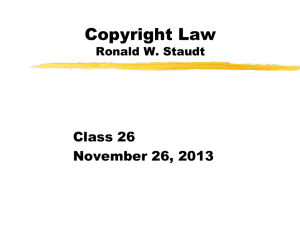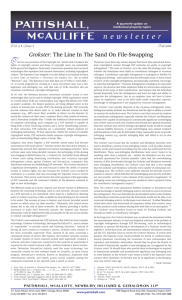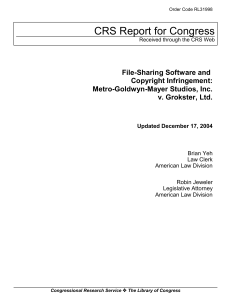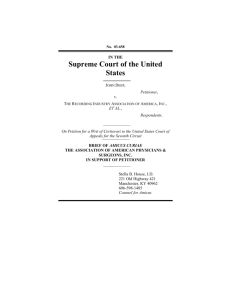Technology Law
advertisement
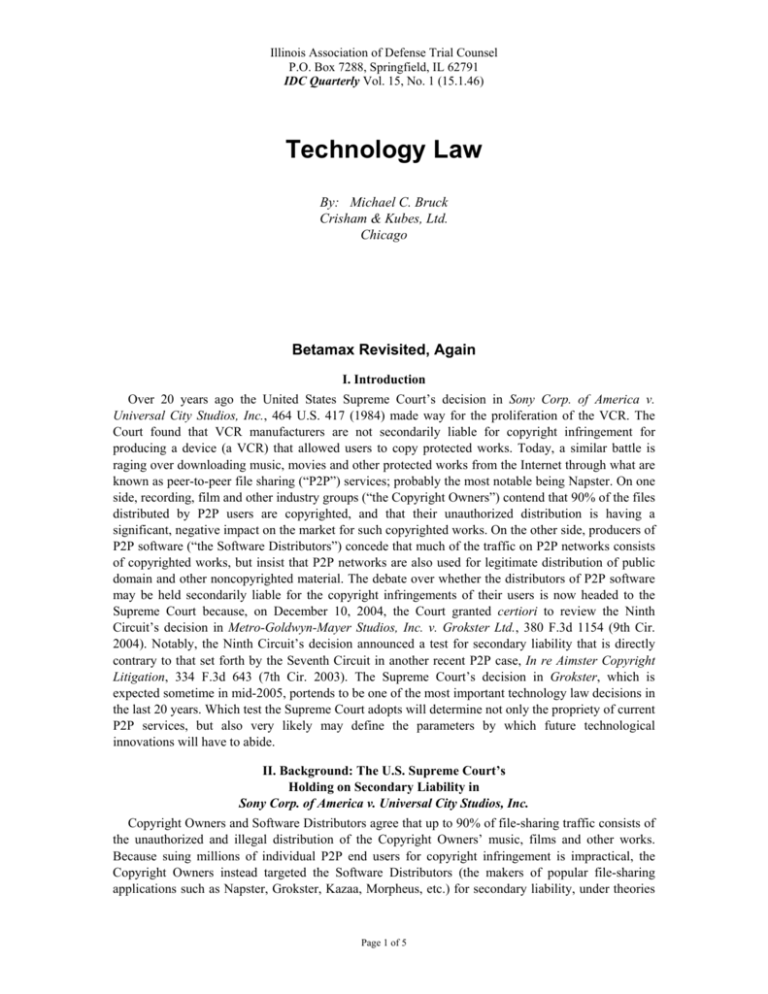
Illinois Association of Defense Trial Counsel P.O. Box 7288, Springfield, IL 62791 IDC Quarterly Vol. 15, No. 1 (15.1.46) Technology Law By: Michael C. Bruck Crisham & Kubes, Ltd. Chicago Betamax Revisited, Again I. Introduction Over 20 years ago the United States Supreme Court’s decision in Sony Corp. of America v. Universal City Studios, Inc., 464 U.S. 417 (1984) made way for the proliferation of the VCR. The Court found that VCR manufacturers are not secondarily liable for copyright infringement for producing a device (a VCR) that allowed users to copy protected works. Today, a similar battle is raging over downloading music, movies and other protected works from the Internet through what are known as peer-to-peer file sharing (“P2P”) services; probably the most notable being Napster. On one side, recording, film and other industry groups (“the Copyright Owners”) contend that 90% of the files distributed by P2P users are copyrighted, and that their unauthorized distribution is having a significant, negative impact on the market for such copyrighted works. On the other side, producers of P2P software (“the Software Distributors”) concede that much of the traffic on P2P networks consists of copyrighted works, but insist that P2P networks are also used for legitimate distribution of public domain and other noncopyrighted material. The debate over whether the distributors of P2P software may be held secondarily liable for the copyright infringements of their users is now headed to the Supreme Court because, on December 10, 2004, the Court granted certiori to review the Ninth Circuit’s decision in Metro-Goldwyn-Mayer Studios, Inc. v. Grokster Ltd., 380 F.3d 1154 (9th Cir. 2004). Notably, the Ninth Circuit’s decision announced a test for secondary liability that is directly contrary to that set forth by the Seventh Circuit in another recent P2P case, In re Aimster Copyright Litigation, 334 F.3d 643 (7th Cir. 2003). The Supreme Court’s decision in Grokster, which is expected sometime in mid-2005, portends to be one of the most important technology law decisions in the last 20 years. Which test the Supreme Court adopts will determine not only the propriety of current P2P services, but also very likely may define the parameters by which future technological innovations will have to abide. II. Background: The U.S. Supreme Court’s Holding on Secondary Liability in Sony Corp. of America v. Universal City Studios, Inc. Copyright Owners and Software Distributors agree that up to 90% of file-sharing traffic consists of the unauthorized and illegal distribution of the Copyright Owners’ music, films and other works. Because suing millions of individual P2P end users for copyright infringement is impractical, the Copyright Owners instead targeted the Software Distributors (the makers of popular file-sharing applications such as Napster, Grokster, Kazaa, Morpheus, etc.) for secondary liability, under theories Page 1 of 5 Illinois Association of Defense Trial Counsel P.O. Box 7288, Springfield, IL 62791 IDC Quarterly Vol. 15, No. 1 (15.1.46) of contributory or vicarious infringement (the copyright equivalent to aiding and abetting in criminal law; see, Aimster, 334 F.3d at 651). “Contributory infringement” applies when “one who, with knowledge of the infringing activity, induces, causes or materially contributes to the infringing conduct of another.” CoStar Group, Inc. v. LoopNet, Inc., 373 F.3d 544, 550 (4th Cir. 2004) (quoting Gershwin Publ’g Corp. v. Columbia Artists Mgmt., Inc., 443 F.2d 1159, 1162 (2d Cir.1971)). “Vicarious liability” applies when the defendant “enjoys a direct financial benefit from the infringing activity and ‘has the right and ability to supervise’ the infringing activity.” Bridgeport Music, Inc. v. Rhyme Syndicate Music, 376 F.3d 615, 621 (6th Cir. 2004) (quoting Ellison v. Robertson, 357 F.3d 1072, 1076 (9th Cir. 2004). The Software Distributors do not dispute that their products are used for illegal purposes, but argue that they cannot be held secondarily liable because their products are also used for some legal purposes. For the last 20 years, the landmark case on this issue (which the Ninth and Seventh Circuits interpreted differently in Grokster and Aimster, respectively), has been Sony Corp. of America v. Universal City Studios, Inc., 464 U.S. 417 (1984). The Sony case arose from the sale of Betamax videocassette recorders in the 1970s and 1980s, which gave consumers the then-novel ability to build personal libraries of broadcast movies and other programs. Universal and other owners of copyrighted television programming opposed the new technology, contending that VCRs (referred to as “VTRs,” or “video tape recorders” in the 1984 decision) were being used to infringe their copyrighted works, and that Sony, as the manufacturer of the machines, should be held secondarily liable for that infringement. The Supreme Court found that VCRs were indeed being used to make unauthorized copies of copyrighted programming, but declined to hold Sony secondarily liable for such infringement because the machines also were used for legitimate, noninfringing purposes. In particular, the Court found that many VCR owners used their machines to “time shift,” or record a program to be watched at a later, more convenient time. Such use, the Court held, amounted to noninfringing fair use, and since VCRs were at least capable of such use, “Sony’s sale of such equipment to the general public does not constitute contributory infringement of [plaintiffs’] copyrights.” Sony, 464 U.S. at 456. The Sony court also set forth a simple bright line test, which has been the settled law in this area for the last two decades: [T]he sale of copying equipment, like the sale of other articles of commerce, does not constitute contributory infringement if the product is widely used for legitimate, unobjectionable purposes. Indeed, it need merely be capable of substantial noninfringing uses. Sony, 464 U.S. at 442. The recent, explosive proliferation of P2P networks–which all parties concerned agree are used mainly for the unauthorized distribution of copyrighted materials–has led to the close examination of this axiom from Sony. The Ninth and Seventh Circuits have come to different interpretations of Sony, with the Ninth Circuit placing predominant importance on the “merely be capable of substantial noninfringing uses” language, and the Seventh Circuit focusing on “if the product is widely used for legitimate, unobjectionable purposes.” III. The Ninth Circuit’s Holding in Metro-Goldwyn-Mayer Studios, Inc. v. Grokster Ltd. Relying on the Supreme Court’s endorsement of the legitimacy of VCRs in Sony, the Ninth Circuit has taken the view that if a file-sharing application is capable of even minimal noninfringing use, its producer is essentially shielded from secondary liability. In Grokster, the Copyright Owners (comprised of a class of 28 major entertainment companies and over 27,000 smaller songwriters and music publishers) brought suit against the distributors of the Page 2 of 5 Illinois Association of Defense Trial Counsel P.O. Box 7288, Springfield, IL 62791 IDC Quarterly Vol. 15, No. 1 (15.1.46) popular Morpheus, Grokster and Kazaa file-sharing programs, alleging that they were contributorily or vicariously liable for their end users’ copyright infringements. The district court granted partial summary judgment in favor of the Software Distributors, finding that their activities did not give rise to liability under either theory. Grokster, 380 F.3d at 1160. The Copyright Owners appealed. In affirming, the Ninth Circuit agreed with the district court that the Software Distributors could not be vicariously liable for their end users’ conduct because such liability requires that the Software Distributors have the right and ability to supervise their end users’ activities. Id. at 1164. While earlier providers of P2P software (e.g., the providers of the seminal P2P service, Napster), had been held liable under this theory of secondary liability, the Ninth Circuit summarily held that the Grokster defendants were shielded from such liability because the configuration of their software removed much of the Software Distributors’ ability to supervise end user conduct. Id. at 1164-66. The bulk of the Ninth Circuit decision, however, was concerned with an analysis of whether the Software Distributors were contributorily liable for end user copyright infringement, which entailed the analysis of Sony. Three elements are required to prove a defendant liable under the theory of contributory copyright infringement: (1) direct infringement by a primary infringer, (2) knowledge of the infringement, and (3) material contribution to the infringement. Grokster, 380 F.3d at 1160. The existence of direct infringement was undisputed, and the element of material contribution was found to be intertwined with the knowledge element (due in part to the particular configuration of the defendants’ software, which also precluded vicarious liability). The dispositive portion of the Grokster court’s analysis thus was directed at whether the second element, knowledge of infringement, had been demonstrated. In an earlier P2P case, A&M Records, Inc. v. Napster, Inc., 239 F.3d 1004 (9th Cir. 2001), the Ninth Circuit construed Sony to apply to the knowledge element of contributory copyright infringement, in that if a defendant could show that its product was capable of substantial or commercially significant noninfringing uses, then constructive knowledge of the infringement could not be imputed. See, Grokster, 380 F.3d at 1160. Rather, if substantial noninfringing use was shown, the copyright owner would be required to show that the defendant had reasonable knowledge of specific infringing files. Id. at 1161. Guided by the Supreme Court’s analysis of the VCR’s potential for noninfringing use, the Ninth Circuit found that the Grokster, Morpheus and Kazaa technology had numerous legitimate, noninfringing uses, such as “significantly reducing the distribution costs of public domain and permissively shared art and speech, as well as reducing the centralized control of that distribution.” Id. at 1164. The Ninth Circuit gave examples of such legitimate use of P2P networks with which it was particularly impressed: One striking example provided by the Software Distributors is the popular band Wilco, whose record company had declined to release one of its albums on the basis that it had no commercial potential. Wilco repurchased the work from the record company and made the album available for free downloading, both from its own website and through the software user networks. The result sparked widespread interest and, as a result, Wilco received another recording contract. Other recording artists have debuted their works through the user networks. Indeed, the record indicates that thousands of other musical groups have authorized free distribution of their music through the internet. In addition to music, the software has been used to share thousands of public domain literary works made available through Project Gutenberg as well as historic public domain films released by the Prelinger Archive. In short, from the evidence presented, the district court quite correctly concluded that the software was capable of substantial noninfringing uses and, therefore, that the Sony-Betamax doctrine applied. Page 3 of 5 Illinois Association of Defense Trial Counsel P.O. Box 7288, Springfield, IL 62791 IDC Quarterly Vol. 15, No. 1 (15.1.46) Id. at 1161-62. Having determined that the Software Distributors’ products were sufficiently capable of substantial noninfringing uses, the Ninth Circuit concluded the Copyright Owners could not impute constructive knowledge of infringement to the Software Distributors, and would instead have to show that they had knowledge of specific infringing files on the P2P networks utilized by their end users. The Copyright Owners could not meet this burden given the decentralized design of the Software Distributors’ programs. Accordingly, the Ninth Circuit affirmed the district court’s grant of summary judgment on the issue of secondary liability. The Copyright Owners appealed the Ninth Circuit decision to the Supreme Court, arguing that the Ninth Circuit’s reliance on the “capable of substantial noninfringing uses” language from Sony was in acknowledged conflict with the Seventh Circuit’s interpretation of that case. See, Copyright Owners’ Petition for a Writ of Certiorari at p. i, 2004 WL 2289200 (Oct. 8, 2004). On December 10, 2004, the U.S. Supreme Court agreed to hear the appeal. Grokster, 73 U.S.L.W. 3247, 2004 WL 2289054 (U.S.). IV. The Seventh Circuit’s Position in In re Aimster Copyright Litigation The Seventh Circuit has also relied on the Supreme Court’s Sony ruling in determining whether the distributors of P2P software may be held liable for the contributory infringement of their end users. However, the Seventh Circuit’s interpretation of the dispositive language in Sony places a greater emphasis on how a product is actually used, rather than how it could be used. The Ninth Circuit concedes that “the Seventh Circuit has read Sony’s substantial noninfringing use standard differently.” Grokster, 380 F.3d 1154 at n. 9. The Seventh Circuit case alluded to by the Ninth Circuit – In re Aimster Copyright Litigation, 334 F.3d 643 (7th Cir. 2003) – places preeminent importance not on the Sony decision’s “capable of substantial noninfringing uses” language, but rather on its “widely used for legitimate, unobjectionable purposes” wording. In Aimster, the Copyright Owners sought an injunction against the distributor of the Aimster P2P file-sharing program, alleging contributory liability under circumstances essentially identical to those in Grokster. The Seventh Circuit rejected the argument made by Aimster, that “all [a Software Distributor] has to show in order to escape liability for contributory infringement is that its file-sharing system could be used in noninfringing ways.” Aimster, 334 F.3d at 651 (emphasis in original). Were that the law, the Seventh Circuit reasoned, “the seller of a product or service used solely to facilitate copyright infringement, though it was capable in principle of noninfringing uses, would be immune from liability for contributory infringement. That would be an extreme result, and one not envisaged by the Sony majority.” Id. (emphasis in original). The Seventh Circuit realized that copyright owners, by nature, seek to characterize any entity that facilitates even a single infringing use as a contributory infringer, and that “[t]o the Aimsters of this world, a single noninfringing use provides complete immunity from liability.” Id. The Seventh Circuit rejected both characterizations. In deciding where between those opposing poles to situate Aimster’s conduct, the Seventh Circuit seized on the tutorial that accompanied the Aimster software, which only gave examples of file-sharing copyrighted works. While the Seventh Circuit sua sponte conceived of five examples of noninfringing use the Aimster software might be used for, the court concluded that “[a]ll five of our examples of actually or arguably noninfringing uses of Aimster’s service are possibilities, but as should be evident from our earlier discussion the question is how probable they are. It is not enough, as we have said, that a product or service be physically capable, as it were, of a noninfringing use.” Id. at 653 (emphasis added). The court thus affirmed the district court’s injunction. Though the Software Distributor’s appeal to the Supreme Court was denied (See, Deep v. Page 4 of 5 Illinois Association of Defense Trial Counsel P.O. Box 7288, Springfield, IL 62791 IDC Quarterly Vol. 15, No. 1 (15.1.46) Recording Industry Ass’n of America, Inc., 540 U.S. 1107 (2004)), the Seventh Circuit’s application of Sony will be reviewed next to the Ninth Circuit’s interpretation this summer, when the Supreme Court considers Grokster. V. Conclusion As the Ninth Circuit pointed out in Grokster, “[f]rom the advent of the player piano, every new means of reproducing sound has struck a dissonant chord with musical copyright owners, often resulting in federal litigation.” 380 F.3d at 1158. File-sharing networks and the MP3 files found on them have proven not to be an exception, and regardless of how carefully the Supreme Court crafts its ruling in Grokster, it is likely that future technological innovations will create conflicts that the existing case law is ill-suited to address. Nevertheless, the Supreme Court’s decision in Grokster likely will be a seminal one, as it will largely determine the extent to which applications for the distribution of movies, music, software and other digital media over the Internet may be developed lawfully. It is difficult to imagine how different the world would be today had the Supreme Court issued a ruling in Sony that would have effectively halted the proliferation of VCRs and related consumer electronics. Regardless of how the Court might rule, the Grokster decision will have a tremendous impact, and is therefore one to watch very closely. ABOUT THE AUTHOR: Michael C. Bruck is a partner in the Chicago law firm of Crusham & Kubes, Ltd. He is a trial lawyer focusing on the defense of professionals in malpractice actions, commercial cases and intellectual property litigation. Mr. Bruck received his B.S. from Purdue University in 1984 and his J.D. from DePaul College of Law in 1988. He is a member of DRI, IDC, ISBA, CBA and The Illinois Society of Trial Lawyers. Page 5 of 5

